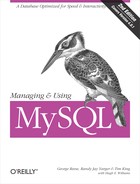Chapter 16. MySQL Data Types
MySQL
offers a wide
variety of data types to support the storage of different kinds of
data. This chapter lists the full range of these data types and
describes their functionality, syntax, and data storage requirements.
For each data type, the syntax shown uses square brackets
([]) to indicate optional parts of the syntax. The
following example shows how BIGINT is explained in
this chapter:
BIGINT[(display_size)]This indicates that you can use BIGINT alone or
with a display size value. The italics indicate that you do not enter
display_size literally, but instead enter your own
value. Thus, possible uses of BIGINT include:
BIGINT BIGINT(20)
Like the BIGINT type above, many MySQL data types
support the specification of a display size. Unless otherwise
specified, this value must be an integer between 1 and 255.
Table 16-1 lists the data types and categorizes them as numeric, string, date, or complex. You can find the full description of each data type later in this chapter.
|
Data type |
Classification |
|
|
Numeric |
|
|
String |
|
|
String |
|
|
String |
|
|
String |
|
|
Date |
|
|
Date |
|
|
Numeric |
|
|
Numeric |
|
|
Numeric |
|
|
Numeric |
|
|
Complex |
|
|
Numeric |
|
|
Numeric |
|
|
Numeric |
|
|
String |
|
|
String |
|
|
String |
|
|
Numeric |
|
|
String |
|
|
String |
|
|
String |
|
|
String |
|
|
String |
|
|
Numeric |
|
|
Numeric |
|
|
Complex |
|
|
Numeric |
|
|
String |
|
|
Date |
|
|
Date |
|
|
String |
|
|
Numeric |
|
|
String |
|
|
String |
|
|
Date |
In the following cases, MySQL silently changes the column type you specify in your table creation to something else:
-
VARCHAR->CHAR When the specified
VARCHARcolumn size is less than four characters, it is converted toCHAR.-
CHAR->VARCHAR When a table has at least one column of a variable length, all
CHARcolumns greater than three characters in length are converted toVARCHAR.-
TIMESTAMPdisplay sizes Display sizes for
TIMESTAMPfields must be an even value between 2 and 14. A display size of 0 or greater than 14 will convert the field to a display size of 14. An odd-valued display size will be converted to the next highest even value.
